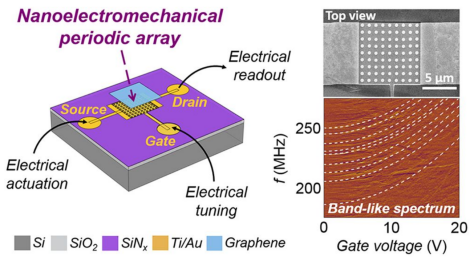Phononic crystals (PnCs) are artificial structural composites with periodic modulation of elastic parameters, and they are capable of regulating the propagation of sound waves. Devices with different geometric parameters have been made to regulate phonon band structure. However, how to achieve field adjustment of band structure remains a challenge.
In a study published in Nano Letters, a research team led by Prof. GUO Guoping and Prof. SONG Xiangxiang from University of Science and Technology of China (USTC) of experimentally demonstrated a graphene-based nanoelectromechanical periodic array (NEMPA) with which the researchers realized a large number of quasi-continuous resonance modes over a large tunable frequency range.
Graphene is a relatively elastic two-dimensional material with mechanical property similar to a thin film. Besides, the good conductivity of graphene makes it possible for applied electric field to stretch the graphene flake and modify its strain, changing its vibration frequency during this process. Therefore, the biggest advantage of graphene is that its resonant frequency could be electrically tuned.
The researchers first etched the uniform periodic array of cylindrical nanopillars on the substrate, and then prepared the electrodes by micro-nano fabrication. Finally, they transferred the graphene with appropriate thickness to the prepared structure, and realized the two-dimensional graphene based NEMPA device.
The researchers found that the device exhibited a large number of quasi-continuous resonance modes in a very large frequency range and that the frequency can be adjusted by the grid voltage. The first trial to apply graphene in a two-dimensional array to form PnCs yields a wide-area tunable resonance effect, heralding the possibilities to use other materials for PnCs formation.
This study provided a promising platform for studying PnCs based on two-dimensional materials and their heterostructures. “We’d like to explore other phenomena in materials besides graphene, and we are going to design other geometric structures such as different arrangements of nanopillar array,” said Prof. SONG.

NEMPA device and electrically tunable resonance modes (Image by ZHANG Qinghang)
Paper link: https://pubs.acs.org/doi/10.1021/acs.nanolett.1c01866
(Written by WANG Yidi, edited by LU Hongyu, USTC News Center)
